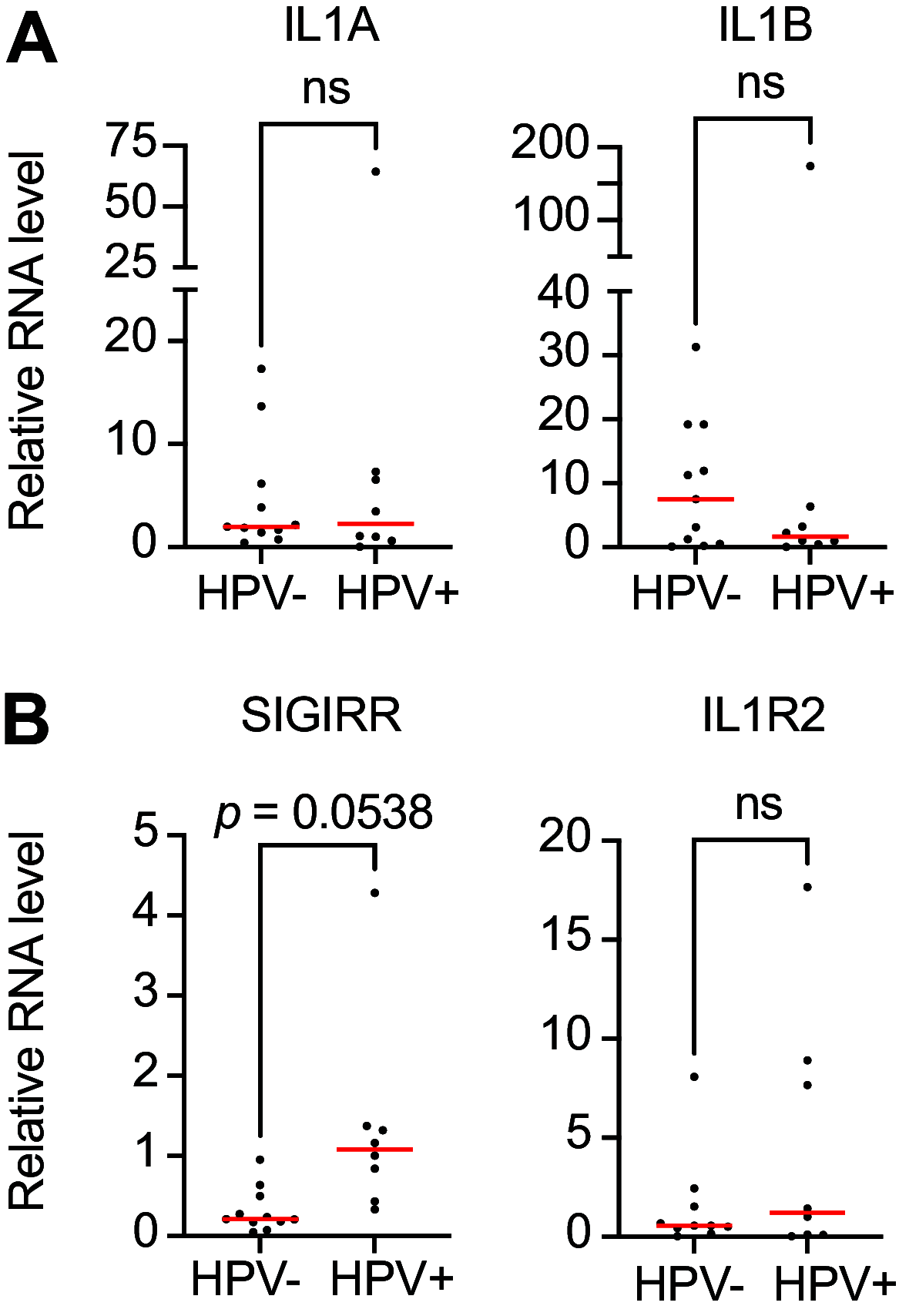Systematic Analysis of IL-1 Cytokine Signaling Suppression by HPV16 Oncoproteins
- PMID: 36342298
- PMCID: PMC9683014
- DOI: 10.1128/jvi.01326-22
Systematic Analysis of IL-1 Cytokine Signaling Suppression by HPV16 Oncoproteins
Abstract
The human papillomavirus (HPV) E6 and E7 oncogenes are expressed at all stages of HPV-mediated carcinogenesis and are essential drivers of cancers caused by high-risk HPV. Some of the activities of HPV E6 and E7, such as their interactions with host cellular tumor suppressors, have been characterized extensively. There is less information about how high-risk HPV E6 and E7 alter cellular responses to cytokines that are present in HPV-infected tissues and are an important component of the tumor microenvironment. We used several models of HPV oncoprotein activity to assess how HPV16 E6 and E7 alter the cellular response to the proinflammatory cytokine IL-1β. Models of early stage HPV infection and of established HPV-positive head and neck cancers exhibited similar dysregulation of IL-1 pathway genes and suppressed transcriptional responses to IL-1β treatment. Such overlap in cell responses supports that changes induced by HPV16 E6 and E7 early in infection could persist and contribute to a dysregulated immune environment throughout carcinogenesis. HPV16 E6 and E7 also drove the upregulation of several suppressors of IL-1 cytokine signaling, including SIGIRR, both in primary keratinocytes and in cancer cells. SIGIRR knockout was insufficient to increase IL-1β-dependent gene expression in the presence of HPV16 E6 and E7, suggesting that multiple suppressors of IL-1 signaling contribute to dampened IL-1 responses in HPV16-positive cells. IMPORTANCE Human papillomavirus (HPV) infection is responsible for nearly 5% of the worldwide cancer burden. HPV-positive tumors develop over years to decades in tissues that are subject to frequent stimulation by proinflammatory cytokines. However, the effects of HPV oncoproteins on the cellular response to cytokine stimulation are not well defined. We analyzed IL-1 cytokine signaling in several models of HPV biology and disease. We found that HPV16 E6 and E7 oncoproteins mediate a broad and potent suppression of cellular responses to IL-1β in models of both early and late stages of carcinogenesis. Our data provide a resource for future investigation of IL-1 signaling in HPV-positive cells and cancers.
Keywords: HPV; IL-1; carcinogenesis; cell growth; cytokine.
Conflict of interest statement
The authors declare no conflict of interest.
Figures








Similar articles
-
HPV16 E6 and E7 expressing cancer cells suppress the antitumor immune response by upregulating KLF2-mediated IL-23 expression in macrophages.J Immunother Cancer. 2025 Aug 19;13(8):e011915. doi: 10.1136/jitc-2025-011915. J Immunother Cancer. 2025. PMID: 40829900 Free PMC article.
-
Human Papillomavirus 16 E6 and E7 Oncoproteins Alter the Abundance of Proteins Associated with DNA Damage Response, Immune Signaling and Epidermal Differentiation.Viruses. 2022 Aug 12;14(8):1764. doi: 10.3390/v14081764. Viruses. 2022. PMID: 36016386 Free PMC article.
-
Modulation of microRNA-mRNA Target Pairs by Human Papillomavirus 16 Oncoproteins.mBio. 2017 Jan 3;8(1):e02170-16. doi: 10.1128/mBio.02170-16. mBio. 2017. PMID: 28049151 Free PMC article.
-
The HPV E6/E7 Oncogenes: Key Factors for Viral Carcinogenesis and Therapeutic Targets.Trends Microbiol. 2018 Feb;26(2):158-168. doi: 10.1016/j.tim.2017.07.007. Epub 2017 Aug 17. Trends Microbiol. 2018. PMID: 28823569 Review.
-
Hallmarks of HPV carcinogenesis: The role of E6, E7 and E5 oncoproteins in cellular malignancy.Biochim Biophys Acta Gene Regul Mech. 2019 Feb;1862(2):153-162. doi: 10.1016/j.bbagrm.2019.01.001. Epub 2019 Jan 29. Biochim Biophys Acta Gene Regul Mech. 2019. PMID: 30707946 Review.
Cited by
-
Interleukins in the Pathogenesis of Warts: Insight from the Last Decade-A Narrative Review.J Clin Med. 2025 Mar 18;14(6):2057. doi: 10.3390/jcm14062057. J Clin Med. 2025. PMID: 40142865 Free PMC article. Review.
-
Impact of high-risk and low-risk human papillomavirus infections on the male genital tract: effects on semen inflammation and sperm quality.Front Cell Infect Microbiol. 2024 Aug 23;14:1420307. doi: 10.3389/fcimb.2024.1420307. eCollection 2024. Front Cell Infect Microbiol. 2024. PMID: 39258253 Free PMC article.
-
HPV16 E7 inhibits HBD2 expression by down-regulation of ASK1-p38 MAPK pathway in cervical cancer.Virol J. 2025 Apr 19;22(1):109. doi: 10.1186/s12985-025-02731-9. Virol J. 2025. PMID: 40253372 Free PMC article.
-
Deciphering the divergent transcriptomic landscapes of cervical cancer cells grown in 3D and 2D cell culture systems.Front Cell Dev Biol. 2024 Aug 13;12:1413882. doi: 10.3389/fcell.2024.1413882. eCollection 2024. Front Cell Dev Biol. 2024. PMID: 39193365 Free PMC article.
-
HPV E6/E7: insights into their regulatory role and mechanism in signaling pathways in HPV-associated tumor.Cancer Gene Ther. 2024 Jan;31(1):9-17. doi: 10.1038/s41417-023-00682-3. Epub 2023 Dec 15. Cancer Gene Ther. 2024. PMID: 38102462 Review.
References
Publication types
MeSH terms
Substances
Grants and funding
LinkOut - more resources
Full Text Sources
Molecular Biology Databases
Research Materials

